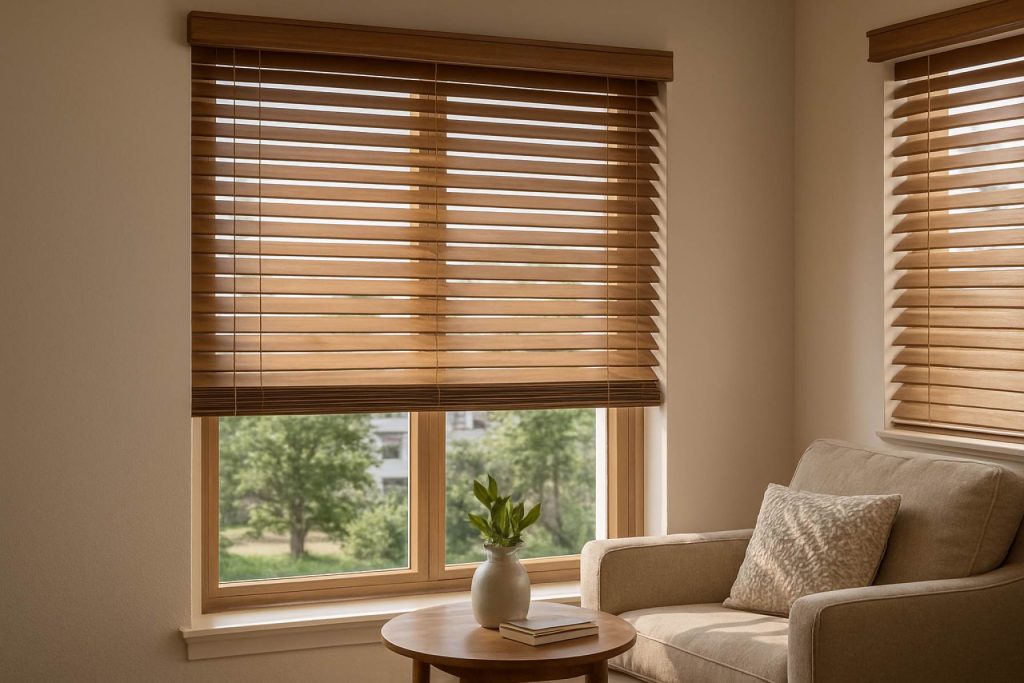
Discover the Versatility of Venetian Blinds: The Ultimate Guide to Style, Privacy, and Light Management for Modern Interiors
- A Brief History of Venetian Blinds
- Materials and Design Options
- How Venetian Blinds Work: Mechanisms Explained
- Benefits of Installing Venetian Blinds
- Choosing the Right Venetian Blinds for Your Space
- Installation and Maintenance Tips
- Venetian Blinds vs. Other Window Treatments
- Trends and Innovations in Venetian Blinds
- Frequently Asked Questions About Venetian Blinds
- Sources & References
A Brief History of Venetian Blinds
Venetian blinds, characterized by their horizontal slats that can be adjusted to control light and privacy, have a history that stretches back several centuries. Despite their name, Venetian blinds did not originate in Venice. Historical records suggest that the concept was brought to Europe from Persia by Venetian traders in the 18th century, which led to their association with Venice. The earliest known patent for a Venetian blind was filed in England in 1769 by Edward Bevan, marking the beginning of their formal use in Western interiors Encyclopædia Britannica.
Throughout the 19th and 20th centuries, Venetian blinds gained popularity in both residential and commercial settings due to their practicality and aesthetic appeal. Their adjustable slats allowed for unprecedented control over sunlight and ventilation, making them a preferred choice for offices and homes alike. The design evolved over time, with the introduction of materials such as aluminum and plastic in the mid-20th century, which made the blinds more affordable and durable Smithsonian Magazine.
Today, Venetian blinds remain a staple in window treatments worldwide, valued for their versatility and timeless design. Their enduring popularity is a testament to their functional innovation and adaptability to changing interior design trends Architectural Digest.
Materials and Design Options
Venetian blinds are available in a wide array of materials and design options, allowing homeowners and designers to tailor window treatments to specific functional and aesthetic needs. The most common materials include aluminum, wood, faux wood, and PVC. Aluminum blinds are lightweight, durable, and resistant to moisture, making them ideal for kitchens and bathrooms. Wood blinds, often crafted from basswood or bamboo, offer a warm, natural look and are favored for living rooms and bedrooms, though they require more maintenance and are less suitable for humid environments. Faux wood blinds, made from composite materials or PVC, mimic the appearance of real wood while providing enhanced moisture resistance and affordability, making them a popular choice for high-humidity areas and budget-conscious consumers.
Design options for Venetian blinds extend beyond material selection. Slat width is a key consideration, with common sizes ranging from 16mm to 50mm. Narrower slats create a more contemporary, streamlined appearance, while wider slats evoke a classic, traditional feel and allow more light when open. Color choices are extensive, from neutral tones to bold hues, enabling coordination with any interior palette. Additionally, finishes such as matte, gloss, or textured surfaces can further customize the look. Some manufacturers offer motorized or cordless mechanisms for enhanced safety and convenience, particularly in homes with children or pets. These diverse materials and design options ensure that Venetian blinds remain a versatile and enduring choice for window coverings Hunter Douglas Levolor.
How Venetian Blinds Work: Mechanisms Explained
Venetian blinds operate through a combination of simple yet effective mechanical components that allow users to control both the amount and direction of light entering a room. The primary structure consists of horizontal slats, typically made from materials such as aluminum, wood, or PVC, which are suspended on ladder cords. These cords run vertically through holes in each slat, supporting and spacing them evenly. The slats can be tilted, raised, or lowered using two main mechanisms: the tilt wand or cord, and the lift cord.
The tilt mechanism, often a wand or a separate cord, is connected to a rod or drum at the headrail (the top casing of the blind). When the wand is twisted or the cord is pulled, it rotates the rod, which in turn moves the ladder cords, causing the slats to tilt open or closed. This action adjusts the angle of the slats, allowing precise control over light and privacy. The lift cord, on the other hand, runs through the slats and is attached to a locking mechanism in the headrail. Pulling the lift cord raises the blinds by gathering the slats at the top, while releasing the cord lowers them to cover the window.
Modern Venetian blinds may also feature cordless or motorized systems for enhanced safety and convenience. Cordless designs use a spring-loaded mechanism, while motorized blinds are operated via remote control or smart home integration. These innovations have improved both the functionality and safety of Venetian blinds, especially in homes with children or pets. For more detailed technical information, refer to Window Covering Manufacturers Association and Encyclopædia Britannica.
Benefits of Installing Venetian Blinds
Venetian blinds offer a range of benefits that make them a popular choice for both residential and commercial spaces. One of the primary advantages is their exceptional control over light and privacy. The adjustable slats allow users to fine-tune the amount of sunlight entering a room, reducing glare and protecting interiors from harmful UV rays. This flexibility also enables occupants to maintain privacy without completely blocking out natural light, which is particularly valuable in urban environments or street-facing rooms (U.S. Department of Energy).
Another significant benefit is energy efficiency. By adjusting the slats, Venetian blinds can help regulate indoor temperatures, keeping spaces cooler in the summer and warmer in the winter. This can lead to reduced reliance on heating and cooling systems, ultimately lowering energy bills (U.S. Department of Energy). Additionally, Venetian blinds are available in a variety of materials, such as aluminum, wood, and PVC, each offering different levels of insulation and durability.
Maintenance is also straightforward, as the horizontal slats can be easily wiped clean, making them a practical option for households with allergies or busy lifestyles. Furthermore, their timeless design and wide range of finishes allow Venetian blinds to complement various interior styles, from modern to traditional. This versatility, combined with their functional benefits, makes Venetian blinds a smart investment for enhancing comfort, efficiency, and aesthetics in any space (Houzz Inc.).
Choosing the Right Venetian Blinds for Your Space
Selecting the appropriate Venetian blinds for your space involves considering several key factors to ensure both functionality and aesthetic appeal. First, assess the room’s purpose and lighting needs. For example, kitchens and bathrooms benefit from moisture-resistant materials like aluminum or faux wood, while living rooms and bedrooms may favor the warmth and texture of real wood slats. The width of the slats also impacts the overall look and light control; wider slats (typically 50mm) offer a more contemporary appearance and greater outside visibility, whereas narrower slats (25mm) provide a classic style and finer light adjustment.
Color and finish are equally important. Neutral tones can blend seamlessly with most interiors, while bold colors or wood stains can serve as a focal point. Consider matching the blinds to existing trim or furniture for a cohesive design. Additionally, the choice between manual and motorized operation can affect convenience, especially for hard-to-reach windows or homes with smart automation systems. Motorized Venetian blinds, for instance, can be integrated with home automation platforms for enhanced comfort and energy efficiency (Somfy Systems).
Finally, measure your windows accurately to ensure a proper fit, and decide between inside or outside mounting based on your window frame and desired look. Consulting with a professional or using online guides from reputable manufacturers like Hillarys can help you navigate the wide range of options and make an informed decision tailored to your space.
Installation and Maintenance Tips
Proper installation and regular maintenance are essential to ensure the longevity and optimal performance of Venetian blinds. When installing Venetian blinds, it is crucial to measure the window frame accurately, accounting for both width and height, to guarantee a snug fit. Most manufacturers provide detailed installation guides, but generally, the process involves securing mounting brackets either inside the window recess (recess fit) or on the wall above the window (face fit). Using a level during installation helps prevent uneven blinds, which can affect both appearance and function. For safety, especially in homes with children, it is recommended to install cord safety devices to minimize the risk of accidents, as advised by the U.S. Consumer Product Safety Commission.
Maintenance of Venetian blinds primarily involves regular dusting and occasional deep cleaning. Dust can be removed using a microfiber cloth, a vacuum cleaner with a brush attachment, or specialized blind dusters. For deeper cleaning, especially for metal or plastic slats, gently wiping with a damp cloth and mild detergent is effective. Wooden blinds require extra care; avoid excessive moisture to prevent warping, and use wood-safe cleaners. It is also important to periodically check the cords and mechanisms for signs of wear or damage, as recommended by the British Blind and Shutter Association. Promptly addressing any issues, such as tangled cords or misaligned slats, can prevent more significant problems and extend the lifespan of the blinds.
Venetian Blinds vs. Other Window Treatments
When comparing Venetian blinds to other window treatments, several distinctive features and advantages become apparent. Venetian blinds, characterized by their horizontal slats—typically made from wood, aluminum, or PVC—offer precise control over light and privacy. By adjusting the tilt of the slats, users can regulate the amount of sunlight entering a room, a flexibility not always matched by alternatives such as roller shades or curtains. This adjustability makes Venetian blinds particularly suitable for spaces where both privacy and variable lighting are priorities.
In contrast, traditional curtains and drapes provide a softer aesthetic and can offer superior insulation, but they lack the granular light control of Venetian blinds. Roller shades and cellular shades, while sleek and often more energy-efficient, generally allow only for full up or down positioning, limiting nuanced light management. Plantation shutters, another popular option, share some similarities with Venetian blinds in terms of slatted design, but are typically more expensive and less flexible in installation.
Maintenance is another area where Venetian blinds stand out. Their slats can be easily dusted or wiped clean, whereas fabric-based treatments may require laundering or professional cleaning. Additionally, Venetian blinds are available in a wide range of materials and finishes, making them adaptable to various interior styles and budgets. For more information on window treatment comparisons, consult resources from the Window Fashion Vision and the Houzz.
Trends and Innovations in Venetian Blinds
Recent years have seen significant trends and innovations in Venetian blinds, driven by advances in materials, automation, and design aesthetics. One of the most notable developments is the integration of smart home technology. Modern Venetian blinds can now be motorized and connected to home automation systems, allowing users to control light and privacy remotely via smartphone apps or voice assistants. This not only enhances convenience but also contributes to energy efficiency by optimizing natural light and reducing reliance on artificial lighting and climate control systems (Somfy Systems).
Material innovation is another key trend. While traditional Venetian blinds were typically made from wood or aluminum, contemporary options include eco-friendly materials such as recycled plastics and sustainably sourced woods. These materials offer improved durability, lighter weight, and a broader range of finishes and colors, catering to diverse interior design preferences (Hunter Douglas).
Design-wise, slimmer slat profiles and minimalist hardware are gaining popularity, reflecting a shift toward sleek, unobtrusive window treatments. Additionally, manufacturers are focusing on child safety by introducing cordless and wand-operated mechanisms to reduce hazards in homes with young children (Window Covering Safety Council).
Overall, the evolution of Venetian blinds is characterized by a blend of technological integration, sustainable materials, and user-centric design, ensuring that these classic window coverings remain relevant and adaptable to modern living environments.
Frequently Asked Questions About Venetian Blinds
Venetian blinds are a popular window treatment, but many homeowners have questions about their use, maintenance, and suitability. Below are answers to some frequently asked questions:
- How do I clean Venetian blinds? Most Venetian blinds can be dusted with a microfiber cloth or a vacuum cleaner with a brush attachment. For deeper cleaning, metal or plastic slats can be wiped with a damp cloth and mild detergent. Wooden blinds should be cleaned with a dry or slightly damp cloth to avoid warping. For more detailed guidance, consult the care instructions provided by the manufacturer, such as those from Hillarys.
- Are Venetian blinds suitable for bathrooms and kitchens? Yes, but material choice is important. Aluminum and PVC blinds resist moisture and are ideal for humid environments, while wooden blinds may warp if exposed to excessive humidity. For recommendations, see English Blinds.
- Can Venetian blinds be motorized? Many modern Venetian blinds can be fitted with motorized controls for convenience and accessibility. This feature is especially useful for hard-to-reach windows. For more information, visit Luxaflex.
- How do I measure my windows for Venetian blinds? Accurate measurement is crucial for a good fit. Most suppliers provide detailed measuring guides, such as Blinds 2go.
For further questions, consult the official websites of leading blind manufacturers or retailers.
Sources & References
- Architectural Digest
- Hunter Douglas
- Levolor
- Window Covering Manufacturers Association
- Houzz Inc.
- Somfy Systems
- Window Fashion Vision
- English Blinds
- Luxaflex



